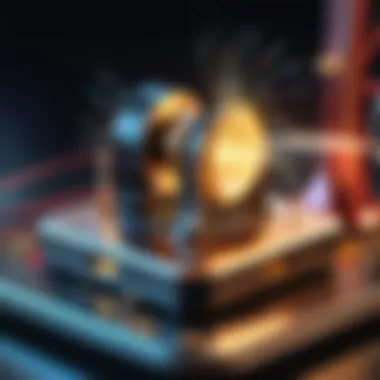Unveiling Nicola Tesla's Innovations and Lasting Impact


Intro
The legacy of Nicola Tesla is often eclipsed by the fame of his contemporaries. Yet, his innovations laid the groundwork for modern electrical engineering and technology. Tesla's vision was not just about the inventions he created but also about how these innovations intertwined with the future. The complexities of his life and work reveal a man ahead of his time, whose ideas resonate in today's tech-driven world.
This exploration will journey through Tesla's key inventions, the obstacles he encountered, and the profound impact he has left behind. From alternating current systems to wireless communication, his contributions are invaluable. Understanding these facets not only honors his genius but also highlights the continuous relevance of his work in contemporary society.
As we traverse Tesla's innovations, we will examine how his thoughts shaped the landscape of technology today and the avenues for future advancements. Let us begin by uncovering the Technology Insights that stem from Tesla's pioneering spirit.
Preface to Nicola Tesla
Nicola Tesla stands as a monumental figure in the history of science and engineering. His innovations have reshaped our understanding of electricity and electromagnetism. By examining Tesla's early life, education, and career developments, we gain insights into his complex character and exceptional genius. This section lays the foundation for understanding his later achievements in electrical engineering and his broader impact on technology and society.
Early Life and Education
Birth and Family Background
Tesla was born on July 10, 1856, in Smiljan, part of modern-day Croatia. His father, Milutin Tesla, was a priest in the Serbian Orthodox Church, while his mother, Georgina Đuka Tesla, was an inventor of household appliances. This familial background instilled in Tesla a rich environment of spirituality and innovation. His mother's inventive spirit likely influenced his future pursuits in electrical engineering. It is crucial to note that early exposure to creativity and education formed the bedrock of Tesla’s curiosity and eventual mastery in technology.
Formal Education
Tesla attended technical school in Graz and later enrolled at the University of Prague. His formal education focused on physics and mathematics, shaping his analytical abilities. These studies enhanced his understanding of various scientific principles. The challenges he faced during his schooling, such as strict academic requirements, reinforced his determination to excel. This period was essential in equipping Tesla with the knowledge that he later applied to his groundbreaking inventions.
Move to the United States
In 1884, Tesla emigrated to the United States with little money but with immense ambition. Upon arrival, he began working for Thomas Edison, a path that would be a pivotal moment in his career. The move symbolized the beginning of his journey to revolutionize electrical engineering. However, it also presented challenges, such as cultural adjustments and financial instability. Nevertheless, this transition laid the groundwork for Tesla's influential work in the field, setting the stage for significant advancements in technology.
Company and Career Developments
Work with Thomas Edison
Tesla's employment under Thomas Edison was both formative and tumultuous. Edison's direct current system was dominant at the time, but Tesla envisioned a more efficient alternating current system. These contrasting perspectives led to tension between them. Nevertheless, this experience allowed Tesla to refine his technical skills and develop critical insights into electrical engineering. Edison's approach also highlights Tesla's later business decisions and ideological pursuits.
Formation of Tesla Electric Company
In 1887, Tesla founded Tesla Electric Company after parting ways with Edison. This company was crucial in promoting alternating current technology. It became synonymous with innovation and quality in electrical engineering. During this time, he filed numerous patents, protecting his intellectual property and securing his standing as a leading inventor. The formation of this company signifies a shift toward independence in Tesla's career and a commitment to developing revolutionary technologies.
Key Partnerships and Collaborations
Tesla's collaborations with investors and scientists were central to his success. Key figures like George Westinghouse recognized the potential of Tesla's inventions, particularly in the realm of AC power. These partnerships provided essential funding and resources for his projects, allowing for the practical implementation of his ideas. However, these relationships also posed risks, as Tesla navigated the competitive landscape of electrical engineering. Their dynamics highlight the essence of collaboration in technological advancement.
"The present is theirs; the future, for which I really worked, is mine." - Nicola Tesla
This section thoroughly examines Tesla's origins and career trajectory. Each element contributed significantly to his later accomplishments and enduring legacy in electrical engineering.
Foundational Contributions to Electrical Engineering
Nicola Tesla's work laid key foundations for the field of electrical engineering. His innovative ideas not only revolutionized energy production and distribution but also sparked advancement in various technologies still prevalent today. Understanding Tesla's contributions helps contextualize much of modern electrical technology.
Alternating Current and the AC Motor
Principles of AC versus
The principles of Alternating Current (AC) and Direct Current (DC) are crucial in understanding Tesla's work. AC allows electricity to change direction periodically, which can be more efficient over long distances. This unique characteristic means that AC can be transmitted at high voltages, requiring less energy loss during transport compared to DC, which flows only in one direction. AC became a beneficial choice for power distribution worldwide.


One key feature of AC is its ability to be transformed into different voltages through transformers. This capacity is vital for integrating electrical systems with varying requirements, making it suitable for industrial and residential use. However, AC systems can be more complex to design and maintain than simpler DC systems.
Development of the Induction Motor
The induction motor is another significant achievement attributed to Tesla. This motor operates on the principle of electromagnetic induction, meaning it does not need a separate power source for its rotor. Its design simplifies construction, leading to lower manufacturing and maintenance costs. The induction motor's impact in various sectors highlights its versatility; it is used in household appliances, industrial machinery, and electric vehicles.
Additionally, the induction motor is noteworthy for its efficiency and reliability. Once in operation, it requires minimal additional energy input. Despite these advantages, the initial complexity in wiring and installation can deter some applications.
Impact on Electrical Power Systems
Tesla's innovations significantly influenced electrical power systems. The widespread adoption of AC technology allowed for the establishment of comprehensive power grids. These grids enable the distribution of electricity over vast distances, which is essential for modern living and economic development.
A primary characteristic of AC systems is their scalability; they can easily adapt to growing energy demands. However, the reliance on AC systems does introduce challenges, particularly in balancing supply and demand fluctuations. Nonetheless, Tesla's contributions built a framework for future energy systems that remains relevant today.
Wireless Communication Innovations
Pioneering Work in Radio Technology
Tesla's pioneering work in radio technology established the groundwork for wireless communication. He envisioned a world where information could be transmitted effortlessly across distances without the need for wired connections. This idea was revolutionary and laid the foundation for what we know today as radio and, subsequently, modern communication networks.
A key trait of Tesla's radio technology is the use of electromagnetic waves to transmit signals. This method was not only innovative but efficient, as it allowed for various applications ranging from communication to navigation. Despite competing claims from contemporaries like Guglielmo Marconi, Tesla's contributions to radio technology are now widely recognized.
Tesla Coil and its Applications
The Tesla Coil is one of Tesla's most famous inventions, showcasing his ability to produce high voltage and high frequency. It serves as a transformer to generate electricity without wires, making it an interesting device in several domains. The Tesla Coil has applications in radio technology and scientific experimentation and is widely used in educational demonstrations to illustrate principles of electricity.
What distinguishes the Tesla Coil is its capability to create spectacular electrical arcs and discharges. While its practical use has evolved, its historical significance cannot be overlooked. It highlights Tesla's ingenious approach to electricity and serves as a visual representation of the principles he aimed to communicate.
Relationship with Guglielmo Marconi
The relationship between Tesla and Guglielmo Marconi is a focal point in the narrative of wireless innovation. While both contributed significantly to radio technology, their paths often crossed in competition. Marconi is primarily credited with inventing the first commercially viable radio system, yet Tesla's earlier patents laid essential groundwork for this technology.
This dynamic of rivalry emphasizes the often contentious nature of scientific advancements. Tesla's insistence on the significance of his discoveries eventually led to legal battles over patent rights, revealing the complexities of intellectual property in innovation. Despite controversies, both figures made indelible marks on the foundation of modern communication.
"It is the greatest of all mistakes to do nothing because you can only do little. Do what you can." - Nicola Tesla
Tesla’s Visionary Ideas
Nikola Tesla's visionary ideas stand as a testament to his far-reaching imagination and unmatched creativity in the world of science and technology. This section investigates two of his most ambitious concepts: wireless energy transmission and the controversial death ray. These ideas illustrate not only Tesla's innovative spirit but also the complexities surrounding his ambitions.
Wireless Energy Transmission
Concept of Global Energy Transmission
The concept of global energy transmission proposed by Tesla was groundbreaking. It revolved around the idea of wirelessly delivering energy across vast distances without the need for traditional electric lines. This concept continues to carry significance as discussions about sustainability and renewable energy grow. One key characteristic of this idea is its emphasis on accessibility; energy could be transmitted to remote areas easily and efficiently.
The unique feature of this global approach is its potential to reduce energy wastage while providing power to underserved populations. However, practical applications have faced considerable challenges. The technology required for fully realized wireless energy systems is still not feasible today, representing both a limitation and a point of intrigue for engineers.
Experiments at Wardenclyffe Tower
The experiments conducted at Wardenclyffe Tower are critical for understanding Tesla’s vision of wireless energy. This site was intended to be Tesla's proving ground for his theories about transmitting electricity without wires. The tower itself symbolizes ambition and innovation. It also represents the challenges Tesla encountered, primarily financial and technical in nature.
A key characteristic of the experiments was the use of resonant frequency. Tesla believed that using this phenomenon could facilitate energy transmission. The unique feature of the experiments was the attempt to harness Earth's natural energy. However, the project's financial failure meant that many of its potential implications were never explored. This remains a point of disappointment in Tesla's legacy, showcasing both audacity and vulnerability.
Long-Term Implications for Energy Delivery


The long-term implications for energy delivery suggested by Tesla's ideas on wireless energy transmission are fascinating. His vision ranged from domestic use to global power availability, indicating an early understanding of energy democratization.
One notable characteristic of these implications is their relevance to current discussions on clean and renewable energy solutions. The unique feature of such implications is the promise they hold for the future. However, the lack of practical technologies to realize these concepts signifies an ongoing challenge. Tesla's proposals serve as inspiration but also highlight the hurdles that must be overcome in the quest for energy equity and accessibility.
Concept of the Death Ray
Development and Theoretical Framework
Tesla's concept of the death ray, much like his other ideas, encapsulates his inventive genius. He proposed a device that could theoretically produce an energy beam capable of incapacitating targets from a distance. This idea was fueled by Tesla's exploration of high-voltage and high-frequency currents.
The key characteristic of the death ray was its intended application in warfare. Tesla believed it could serve as a deterrent against conflict by making war too costly. The essence of the development framework revolved around the fusion of physics and engineering principles, supported by Tesla's extensive knowledge. Nonetheless, the practicality of such a weapon remains untested and controversial, leading to a mix of fascination and skepticism.
Military Interest and Controversy
Tesla's death ray garnered significant military interest during his lifetime. Various factions explored the potential applications for national defense. This interest, however, was marred by controversy. Many questioned the ethical implications and the possible arms race it could incite.
The key characteristic of this military interest reflects society's wrestling with the morality of advanced technologies. The unique features of this controversy illuminate the thin line technology walks between innovation and destructiveness. As a result, the idea has inspired both films and literature, further cementing its presence in popular culture.
Legacy of the Idea in Popular Culture
The legacy of the death ray in popular culture remains compelling. It has captured the imagination of many, viewed as both a symbol of technological prowess and a harbinger of doom. This duality makes the topic particularly engaging.
The key characteristic of this legacy is its transformational impact on how society perceives inventors and scientists. The unique feature of the death ray's portrayal in various forms of media highlights the tension between human creation and its potential consequences. Tesla's idea serves as a cautionary tale, reminding us that the pursuit of knowledge carries responsibilities as well as opportunities.
Challenges and Controversies
The Challenges and Controversies surrounding Nicola Tesla hold significant relevance in understanding his contributions and setbacks. Tesla's life was marked by an ongoing struggle against various external factors that impacted his work, including financial troubles and public perception. Examining this topic provides a comprehensive view of how these challenges shaped his inventions and legacy. It highlights the dynamic nature of Tesla's environment, reflecting the complexities of innovation in the late 19th and early 20th centuries.
Struggles with Financial Backers
Key Financial Partnerships
Tesla's financial partnerships were crucial to his ability to innovate. His relationship with prominent investors like J.P. Morgan significantly impacted the trajectory of his work. These partnerships provided essential funding for many of his ambitious projects, such as the Tesla Electric Company. However, this dependency also placed him at the mercy of investors who often had different visions for his technology. The unique feature of these partnerships was their capacity to fuel Tesla's ideas while simultaneously constraining them. This dichotomy illustrates the precarious balance many inventors face in securing necessary financial backing.
Problems with Funding
Problems with funding plagued Tesla throughout his career. Even when initial investments were secured, sustaining that funding proved more difficult. For example, after the initial enthusiasm for the potential of alternating current, financial support dwindled. This inconsistency forced Tesla to pivot frequently, redirecting his focus toward projects with more immediate financial backing. The constant need to seek funding diverted attention from his core innovations, illustrating a significant drawback for inventors reliant on external capital.
Impact on Inventions and Projects
Tesla's struggles with financial backers fundamentally impacted his inventions and projects. Many of Tesla's groundbreaking ideas, like wireless power transmission, faced delays or were ultimately abandoned due to lack of funding. The inherent risk in his experimental approaches made investors hesitant. Consequently, Tesla's groundbreaking work could have been more extensive. This characteristic of his funding challenges ultimately limited the scope and application of his technological advancements.
Public Perception and Rivalries
Public Image through the Media
Public perception shaped Tesla's image, largely influenced by media portrayals. In his early years, Tesla enjoyed a favorable image, hailed as a genius. However, as his career progressed, this perception fluctuated, particularly during high-profile rivalries. The media often sensationalized these conflicts, affecting public opinion. Public image through the media thus became a double-edged sword, helping to build Tesla’s fame while simultaneously complicating his personal narrative.
Rivalry with Edison and Westinghouse
The rivalry with Thomas Edison and George Westinghouse was a defining aspect of Tesla’s career. This competition over alternating versus direct current epitomized the larger battle for domination in the electrical industry. Tesla’s AC system ultimately prevailed, but the tension strained relationships and tarnished reputations. This rivalry highlights the idea that scientific advancement does not happen in a vacuum; rather, it often involves intense interpersonal conflicts that influence public and professional standing.
Reputation in Later Years


In his later years, Tesla's reputation underwent significant transformation. Once celebrated, he faced neglect as newer innovations emerged. The combination of financial setbacks and waning media attention contributed to a decline in public perception. Despite this, Tesla’s ideas began to receive renewed interest in the years following his death. The unique aspect of this legacy shift illustrates how time can alter perceptions of innovators, leading to a complex and layered understanding of their contributions.
"The present is theirs; the future, for which I really worked, is mine." - Nikola Tesla
Ultimately, addressing these challenges and controversies is vital for understanding Tesla's multifaceted legacy. It highlights not only his brilliance but also the obstacles that innovators often face in their pursuits.
The Legacy of Nicola Tesla
Tesla's legacy is a reflection of his profound influence on both technology and culture. This section highlights how his innovations shaped the modern world and how his ideas continue to resonate in various fields today. The importance of Tesla's contributions cannot be overstated; they pave the way for advancements that define contemporary life. Furthermore, his image as a brilliant yet misunderstood inventor has turned him into a cultural icon. Understanding his legacy gives insight into how imagination and scientific rigor can drive progress.
Influence on Modern Technology
Relevance of AC Power Systems Today
The alternating current (AC) power system, which Tesla championed, remains the backbone of electrical distribution worldwide. Its efficiency over long distances and ability to power homes and industries make it a pivotal aspect of modern infrastructure. Public utilities rely on AC systems, benefiting from the reduced power loss compared to direct current (DC). This relevance enhances our daily living conditions and supports an expanding digital landscape. Without Tesla's contributions to AC, our current technological framework would be vastly different.
Tesla’s Influence on Contemporary Inventors
Tesla's innovative spirit inspired numerous contemporary inventors and engineers. His work has become a foundational pillar on which many modern inventions stand. Thinkers like Steve Jobs and Elon Musk often cite Tesla as a catalyst for their ideas. The emphasis Tesla placed on sustainability and renewable energy sources is particularly impactful today. His persistence shows future innovators the importance of thinking beyond current limits, thus igniting the spark of creativity in others.
Recognition and Tributes
Recognition of Tesla's work has surged in recent years. Statues, awards, and even the naming of the electric car company, Tesla, Inc., honor his legacy. The increasing emphasis on sustainability aligns with his vision for a world powered by clean energy. Such tributes not only celebrate achievements but also educate the public about his crucial role in technological evolution. However, there is a risk of mythologizing him, which could obscure the scientific rigor that defines his work.
Cultural Impact and Mythos
Tesla in Literature and Film
The portrayal of Tesla in popular literature and film has cemented his status as a cultural icon. Works such as the novel "The Invention of Everything Else" by Samantha Hunt and films like "The Prestige" highlight his eccentric personality and revolutionary ideas. This representation brings awareness to his contributions, but it also runs the risk of distorting historical facts. While engaging, these portrayals may oversimplify complex narratives surrounding his life and work.
The Creation of the Tesla Brand
The Tesla brand has grown significantly, not just as a car manufacturer, but as a symbol for innovation and sustainability. The brand evokes a sense of modernity and forward-thinking, deeply connected to the values Tesla himself championed. However, this strong brand identity can sometimes overshadow the scientific nuances and historical contexts of Tesla’s inventions. Merging business with innovation remains a delicate balance in honoring his legacy.
Public Fascination with the Figure of Tesla
Public fascination with Tesla is rooted in his mysterious persona and unparalleled intellect. His life story resonates with those who appreciate underdog narratives, serving as a reminder of how true visionary ideas can be overlooked. Social media and platforms like Reddit continue to fuel discussions about his life and contributions, further promoting interest. This fascination, while beneficial for educational outreach, may also create unrealistic expectations regarding the progress of scientific advancements, thus complicating public understanding of the timeline of innovation.
"Tesla's teachings remain a beacon for inventors, a blend of curiosity and relentless pursuit of knowledge."
Through these complex elements, the legacy of Nikola Tesla illustrates the interplay between technology, culture, and imagination. His contributions are not only crucial to the functionality of today’s world but also serve as inspiration for future generations.
The End
Tesla’s Enduring Relevance
Enduring Innovations and Ideas
Nikola Tesla’s innovations have a lasting impact on modern electrical engineering. His work laid the groundwork for the systems that power our lives today. The most notable aspect of his inventions is the development of alternating current (AC), which remains the global standard for electricity transmission. The enduring relevance of this technology is evident in its widespread adoption and efficiency compared to direct current (DC). AC power’s ability to be transmitted over long distances with minimal energy loss makes it a preferable choice for electrical grids. Moreover, innovations such as the Tesla coil continue to be utilized in various fields, including telecommunications and power generation.
The Importance of Tesla’s Vision
Tesla's visionary ideas transcend contemporary engineering limitations. He foresaw the potential of wireless communication and energy transfer, concepts that are increasingly relevant in today’s interconnected world. The unique characteristic of Tesla's vision lies in its forward-thinking nature; he imagined a future where energy could flow freely and abundantly without wires. This anticipation not only contributed to the foundations of radio technology but also offered insights into renewable energy solutions. Understanding the breadth of Tesla’s vision helps us to appreciate its implications for sustainable energy utilization, making it a vital aspect of our analysis in this article.
Final Reflections on his Contributions
Tesla's contributions to science and technology are profound and widespread. One significant aspect of his legacy is the shift in how we perceive energy—moving from a limited resource to an accessible utility. His ideas sparked progress in fields ranging from electromagnetism to robotics. Reflecting on Tesla's work invites us to recognize the continuous evolution of technology, where his influence remains integral. The unique aspect of these reflections is the continual relevance of his theories in modern developments, reinforcing their importance in contemporary discussions about technology and innovation.
"The present is theirs; the future, for which I really worked, is mine." - Nikola Tesla
Tesla's life and contributions are nothing short of a testament to the power of innovative thought. His enduring relevance highlights the significance of visionary ideas in shaping our technological landscape.







